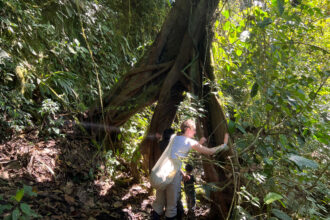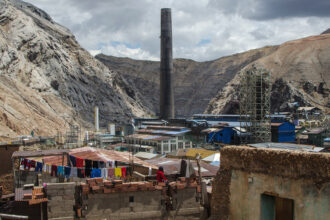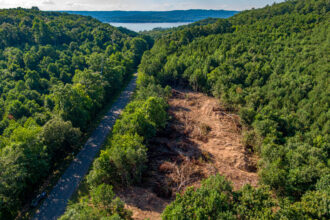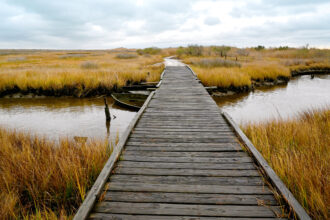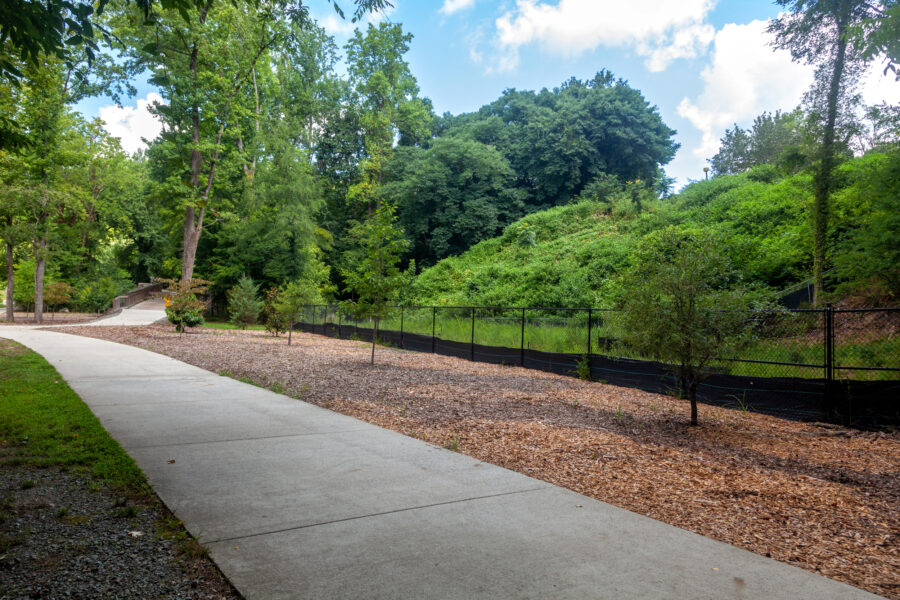A new lawsuit asks Colombia to recognize that jaguars, military macaws and the nation’s tropical dry forest have legal rights to “life, health and integrity.”
The case is the latest in the “rights of nature” movement, which aims to garner recognition from courts and legislatures that ecosystems and individual species have legal rights, similar to humans and nonhuman entities like corporations.
According to the complaint, filed earlier this month by the nonprofit Amar Madre Tierra Foundation, mining operations have violated the rights of the tropical dry forest—Colombia’s most threatened ecosystem—as well as jaguars and macaws living in the vicinity of Sierra Nevada de Santa Marta, a mountain range in Northern Colombia.
The lawsuit, filed with a Colombian court in the Magdalena region, also asks the court to recognize the rights of sacred Indigenous spaces located throughout the tropical dry forest of the Sierra Nevada de Santa Marta.
Colombia’s tropical dry forest was once the size of Maine. Only about eight percent is left. Known as the “forest of a thousand colors” for its dense greenery and flowering trees in the rainy season, the region is home to hundreds of rivers and streams that supply drinking water to more than a million people. Local communities also rely on it for cultural wealth and livelihoods.
The complaint alleges that, since 2007, mining operations for construction materials’ have negatively impacted the forest and sacred spaces by contaminating rivers and streams, generating noise pollution, and releasing excessive amounts of dust into the atmosphere. Those mining impacts, combined with other development, have put the ecosystem into “a critical state of fragmentation and degradation,” the complaint says.
Habitat loss and degradation is the main driver of population decline among Colombian jaguars, critically endangered in the country, and military macaws, which are considered threatened. In addition to extractive activities like mining, the species face threats from agricultural and cattle ranching expansion, urbanization, fire, unsustainable tourism, hunting and poaching.
For jaguars, the loss of habitat shrinks the availability of food sources, driving the cats to feed off livestock populations and, in turn, making them a target of illegal killings by ranchers defending their herds. The complaint cites reports of at least three attempted killings of jaguar adults, one of which was a mother with two cubs that appeared to be looking for food near farms.
Military macaw populations have also dropped in Colombia due to the demand within and outside the country for their sale as pets. Macaws are one of the most trafficked birds in the illegal wildlife trade, which is estimated to be worth at least $7 billion annually. Jaguars are also highly sought out by traffickers, with high demand for their body parts coming from China for use in Eastern medicine practices.
Both jaguars and macaws are considered “umbrella” species: They are indicators of overall habitat health. Protecting them has cascading benefits for the ecosystems in which they live. In Colombia, their habitats in the Sierra Nevada de Santa Marta are also home to hundreds of other species, including endangered and endemic plants and animals including harlequin toads, spectacled bear and the black-and-chestnut eagle.
Lawyers and advocates behind the rights of nature movement argue that, compared to conventional anti-pollution regulations, rights-based laws can afford ecosystems a higher degree of protection while helping to reshape humanity’s thinking about its relationship with the natural world. Rights of nature laws, they say, are grounded in the understanding that Earth is a community of living beings and that humans are part of that framework of life, rather than separate from it.
Often, the legal strategy behind rights of nature cases ties together the rights of Indigenous and local communities with the rights of ecosystems, emphasizing that human wellbeing is dependent on a healthy environment. The movement has taken off throughout South America largely because of the high population of Indigenous people and local communities living close to nature.
In the Sierra Nevada de Santa Marta, four Indigenous peoples, the Arhuaco, Kogui, Kankuamo and Wiwa, have over thousands of years developed vast cultural and ecological knowledge about management of the forest, which they consider to be the “heart of the world.” As of last year, at least 150 mining licenses have been issued in the region, with more than 130 mining applications pending, according to data from the National Mining Agency.
The complaint filed by the Amar Madre Tierra Foundation alleges that existing conservation laws are inadequate and ineffective, and alleges that impacted Indigenous communities were not adequately consulted about mining and other development projects, as required by Colombian and international law.

The complaint asks the court to revoke a mining license issued to the Colombian company Mincivil Topco. The plaintiff also wants a judge to order national and local governments to fully comply with their obligations to uphold the rights of Indigenous communities and to carry out restoration projects in the affected areas of the Sierra Nevada de Santa Marta region.
A lawyer with Amar Madre Tierra Foundation said that the lawsuit invites the court to adopt a “biocultural” approach that prioritizes ecosystems’ “vital processes” and connection to Indigenous communities and those communities’ ancestral knowledge systems and values. The lawyer, who is based in the Sierra Nevada de Santa Marta region, asked that their name not be used for safety reasons because of the dangers facing environmentalists in the country.
“We need to stop conceiving of the jaguar, macaw and other parts of nature as resources and sources of income,” the lawyer said.
Neither mining firm Mincivil Topco, a named defendant in the case, nor the Colombian embassy in Washington, D.C., responded to a request for comment about the lawsuit.
How Rights of Nature Has Evolved in Colombia
In Colombia, the rights of nature as legal and cultural concepts are not new.
At least seven court rulings in the country have recognized the rights of ecosystems and species, though critics characterize the enforcement of those rulings as inadequate, and in one case, adverse to local communities.
The movement took root in the country in the mid-2010s, as a coalition of Indigenous and Afro-descendant communities prevailed in a lawsuit against the federal government over widespread contamination and degradation of the Atrato River basin. The basin, located in the country’s Northwest Chocó region and abutting the border with Panama, faces armed conflict, drug trafficking, illegal logging and mining.
This story is funded by readers like you.
Our nonprofit newsroom provides award-winning climate coverage free of charge and advertising. We rely on donations from readers like you to keep going. Please donate now to support our work.
Donate NowIn 2016, Colombia’s Constitutional Court, one of the country’s four coequal judicial bodies, ruled that those activities violated locals’ rights to a healthy environment and said that the river basin possesses the rights to be protected, restored, maintained and conserved. The ruling also required the appointment of ecosystem guardians—a community member and government official charged with restoring the ecosystem’s health.
Since the ruling came down, governmental security forces acted to dismantle mining operations in the region. But when those security forces pulled back, armed groups linked to the mining retaliated against communities.
A governmental commission tasked with following up on the implementation of the ruling warned of serious problems in a 2022 report, the most recent available on its website. Illicit mining operations increased. Water testing showed more heavy metals—arsenic, lead and mercury—in sediments compared to 2019 tests. And the region still had “basic sanitation issues.”
These enforcement challenges are not exclusive to rights of nature rulings, said Constanza Prieto Figelist, Latin American legal director for the nonprofit Earth Law Center. Prieto Figelist has advised rights of nature activists throughout South America on litigation and legislative strategies. She noted that judicial rulings on human rights, general environmental law and other areas of the law also take time to enforce and said it’s impossible to repair damage done over centuries in just a few years.
Expecting rights of nature laws to change that overnight is, she said, “not realistic.”
Other rulings have brought unintended consequences.
Two years after the Atrato River basin judgment, Colombia’s Supreme Court handed down a sweeping order recognizing that the entire Colombian Amazon rainforest had rights. The case was brought by 25 youths claiming that deforestation, by worsening climate change, violated their right to a healthy environment.
The decision was widely praised by environmentalists and rights activists as a game-changing legal precedent that advanced intergenerational equity and legal pluralism through the inclusion of nature’s rights, which is seen as inclusive of Indigenous’ belief systems.
That praise, however, quickly turned to criticism of the Colombian government’s enforcement of the ruling. In 2019, the administration of then-president Iván Duque rolled out “Operation Artemisa,” a military campaign aimed at dismantling criminal organizations responsible for land grabbing and clearing so that illicit livestock pasture, crops, mining and logging can take place.
The Duque administration said Artemisa conserved over 27,000 hectares of forest—an area slightly larger than the state of West Virginia—throughout the country in 2019. But Colombia lost roughly 171,000 hectares the following year as law enforcement activity was constrained by the pandemic.
Artemisa was also criticized for excluding affected Indigenous communities in the design of the campaign and for allegedly targeting forest-dwelling communities carrying out subsistence activities while financiers of deforestation were overlooked.
Dwirunney Torres, an Arhuaco Indigenous leader based in Colombia’s Sierra Nevada de Santa Marta region, said the impacts on Indigenous communities from Artemisa is a reason why Indigenous communities ought to be included from the start in conservation advocacy and planning, including rights of nature lawsuits. If they had had a voice in the lawsuit, they could have shaped the judgment to ensure Indigenous communities were not negatively affected by the rulings’ enforcement, he said.
“We are the ones who know how our territory, and everything within it, should be protected and cared for as we have done it for millennia,” he said. “We are not minors, and we do not need outsiders to make decisions without us.”
About This Story
Perhaps you noticed: This story, like all the news we publish, is free to read. That’s because Inside Climate News is a 501c3 nonprofit organization. We do not charge a subscription fee, lock our news behind a paywall, or clutter our website with ads. We make our news on climate and the environment freely available to you and anyone who wants it.
That’s not all. We also share our news for free with scores of other media organizations around the country. Many of them can’t afford to do environmental journalism of their own. We’ve built bureaus from coast to coast to report local stories, collaborate with local newsrooms and co-publish articles so that this vital work is shared as widely as possible.
Two of us launched ICN in 2007. Six years later we earned a Pulitzer Prize for National Reporting, and now we run the oldest and largest dedicated climate newsroom in the nation. We tell the story in all its complexity. We hold polluters accountable. We expose environmental injustice. We debunk misinformation. We scrutinize solutions and inspire action.
Donations from readers like you fund every aspect of what we do. If you don’t already, will you support our ongoing work, our reporting on the biggest crisis facing our planet, and help us reach even more readers in more places?
Please take a moment to make a tax-deductible donation. Every one of them makes a difference.
Thank you,








